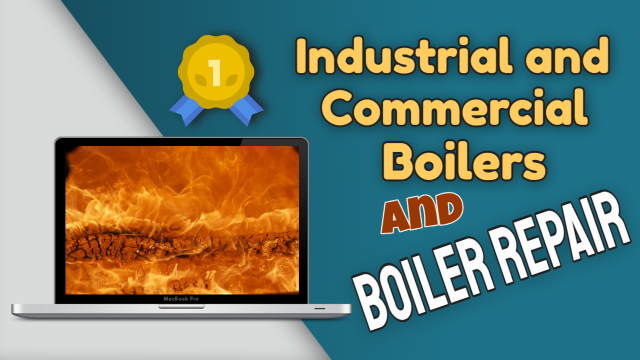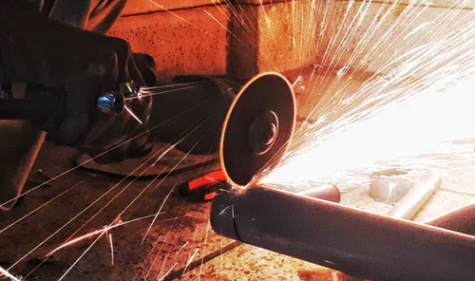Industrial and Commercial Boilers and Boiler Repair
by Gordon Brown
Affiliate Disclosure ...
THIS PAGE MAY CONTAIN AFFILIATE LINKS, MEANING WE RECEIVE A COMMISSION IF YOU DECIDE TO MAKE A PURCHASE VIA OUR LINKS, THERE IS NO COST TO YOU ... PLEASE READ OUR FULL DISCLOSURE FOR MORE INFO ... THANK YOU!
Posted on 03-03-2020 03:00 AM

On This Page
- Boiler Repair: Top Reasons Why You Should Hire a Heating Service
- Get a professional boiler repair service right away
- Why Use a Tube Furnace?
- Two More Custom Industrial Furnaces from Thermcraft
- How Does a Melting Furnace Work?
- Lab Furnace Safety
- The Differences Between an Industrial Oven and an Industrial Furnace
- The Components Within a Gas Fired Industrial Furnace
In this article we focus on boiler repair: for commercial and industrial furnaces used for heating and hot water. It is important that businesses are ready if the boiler stops working, as the loss of heating can easily very quickly cost your company a lot of money.
Boiler Repair: Top Reasons Why You Should Hire a Heating Service
A boiler repair or maintenance is very important whether it is summer or winter.  You need to be prepared that your hvac system is functioning for both seasons. Most homeowners often oversee to check their hvac system in advance. That's why it is common for them to face issues during the winter and summertime.
You need to be prepared that your hvac system is functioning for both seasons. Most homeowners often oversee to check their hvac system in advance. That's why it is common for them to face issues during the winter and summertime.
They either experience a sudden stop in the function of their unit or worst it works limitedly. And you don't want your air-conditioning to stop during the summer period right? or experience the cold winter night because your boiler is not working anymore.
That is why you should hire a heating service for your hvac system. Although there are many diy's that you can find online for hvac maintenance, it is still best to leave the job to a professional. Chances are your hvac system needs a boiler repair that only professional treatment can solve.
We don't want you to experience having cold hands and feet during winter. And the same ways to sweat like a pig during the summer days. That is why we listed below some of the top reasons why you should hire a heating service provider for your boiler repair.
Get a professional boiler repair service right away
Whether you’ve built a new home or your old furnace is simply beyond repair, we have a large selection of premium new furnaces from which you can choose. Our experts can help you select the right fit for your budget, the size of your home, and your energy goals. Best of all, we pair all of our products with professional furnace installation services.
Why Use a Tube Furnace?
 A tube furnace heating unit is a device used to heat air for residential homes and commercial buildings. It is one of the oldest types of heating systems still in use today. Older versions were powered by coal and wood versus today’s modern versions, which burn natural gas, propane and electricity to produce heat.
A tube furnace heating unit is a device used to heat air for residential homes and commercial buildings. It is one of the oldest types of heating systems still in use today. Older versions were powered by coal and wood versus today’s modern versions, which burn natural gas, propane and electricity to produce heat.
There are several types of these furnaces, single stage, two-stage and variable speed — on the market today with each having specific characteristics, costs and efficiency ratings.
Custom Industrial Furnaces
A natural gas furnace typically operates using a conventional burner, which uses a pilot light and a gas feed to produce a flame that is contained within a refractory burner tile. The fuel may be introduced as a pre-mix of natural gas and air or multiple feeds may supply pure fuel and primary air to produce a safe and steady flame.
There are both benefits and drawbacks to this technology. In this blog post, thermcraft will explore some of the pros and cons of using a natural gas furnace in more detail. Cost of natural gas furnaces the upfront cost of any furnace largely depends upon its scale, the complexity of its architecture, and any additional functionalities that your application might require.
A natural gas furnace may be more expensive to install if it requires plumbing into a supply line – which is typically the case. Compressed natural gas (cng) can be used if a supply line is unavailable.
How Does a Melting Furnace Work?
Rocks with bits of iron in them + rocks with lots of limestone in them and then, heat all of them up to a really, really, really hot temperature, amazing things happen: both those kinds of rocks melt. Yes, they actually change from solid rocks into runny liquid. Plus, the limestone is a magnet for all the rock-ish bits and impurities which are not iron. .
 Named after early iron smelting furnaces along the cuyahoga river, furnace run stream passes through the 890-acre furnace run metro park, which began in 1929 when the family of charles francis brush jr. Donated 272 acres to summit metro parks.
Named after early iron smelting furnaces along the cuyahoga river, furnace run stream passes through the 890-acre furnace run metro park, which began in 1929 when the family of charles francis brush jr. Donated 272 acres to summit metro parks.
Much of the park was developed by work relief crews during the 1930s. Brushwood lake, a once-popular swimming spot before erosion and sedimentation forced its closing in 1956, was created by diverting the natural flow of the furnace run stream.
Furnaces and boilers can be retrofitted to improve the safety and efficiency of otherwise sound, older systems. The costs of retrofits should be carefully weighed against the cost of a new boiler or furnace, especially if replacement is likely within a few years or if you wish to switch to a different system for other reasons, such as adding air conditioning.
Retrofits are fuel-specific, so see the following sections for retrofit information: other retrofitting options that can improve a system's energy efficiency include installing programmable thermostats , upgrading ductwork in forced-air systems, and adding zone control for hot-water systems, an option discussed in heat distribution systems.
The Differences Between an Industrial Oven and an Industrial Furnace
A furnace is an appliance that heats houses and buildings by burning fuel or circulating hot water. Your furnace might rumble in the basement, sending heat up through your house's radiators. Most houses in cold climates have a furnace, to warm their rooms during the chilly months of the year.
Furnaces have industrial uses, like burning trash or extracting ore from metal. If someone says, "it's as hot as a furnace in this classroom!" they mean that it's extremely hot. Furnace comes from the old french fornaise, "oven," with the latin root word fornacem, "oven or kiln. ".
A furnace is a device used to heat and melt metal ore to remove gangue. The name derives from latin word fornax, which means oven. The heat energy to fuel a furnace may be supplied directly by fuel combustion , by electricity such as the electric arc furnace , or through induction heating in induction furnaces. In american english and canadian english usage, the term furnace refers to the household heating systems based upon a central furnace, otherwise known either as a boiler , or a heater in british english.
Furnace may also be a synonym for kiln , a device used in the production of ceramics. In british english , a furnace is an industrial furnace used for many things, such as the extraction of metal from ore ( smelting ) or in oil refineries and other chemical plants, for example as the heat source for fractional distillation columns.
The term furnace can also refer to a direct fired heater, used in boiler applications in chemical industries or for providing heat to chemical reactions for processes like cracking, and is part of the standard english names for many metallurgical furnaces worldwide.
The first category of furnaces are natural draft, atmospheric burner furnaces. These furnaces consisted of cast-iron or riveted-steel heat exchangers built within an outer shell of brick, masonry, or steel. The heat exchangers were vented through brick or masonry chimneys. Air circulation depended on large, upwardly pitched pipes constructed of wood or metal. The pipes would channel the warm air into floor or wall vents inside the home. This method of heating worked because warm air rises.
The Components Within a Gas Fired Industrial Furnace
The steam-generating industry also had to develop new boilers in response to non-commercial or industry demands. By the late 1970s and early 1980s, the growing disposal costs for landfills, the passage of the public utility regulatory policies act of 1978, and an increased demand for electric power in the united states led to the development of alternative fuel–burning boilers. Many different types of boilers began to be designed to burn alternative fuels such as refuse (trash), wood, and biomass (vine clippings, leaves, grasses, bamboo, and sugar cane or bagasse).

